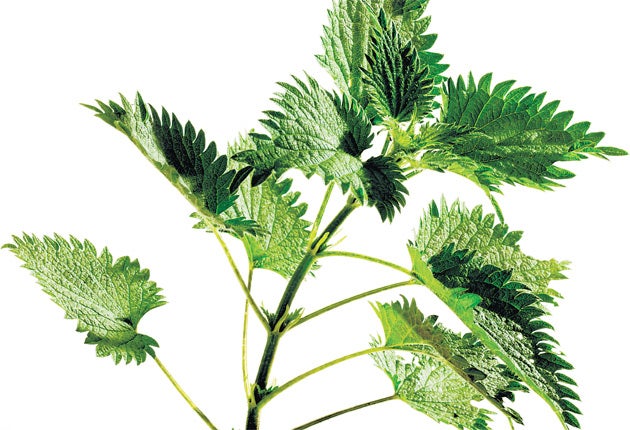Nettles - all zing, no sting
Whether it’s cocktails or risottos, salads or soups, top restaurants and savvy producers have a new ingredient that’s delicious and cheap. Alice-Azania Jarvis grasps the nettle

Prickly, scratchy, and having a nasty sting – on first inspection, nettles have little to recommend them. The lowpoint of any childhood trip to the park was a brush with them – their only friend was the soothing dock leaf. They are abundant – tufting precariously out of the grass – and yet no one wants anything to do with them.
Well, until now. Perusing the drinks list for the Zetter Townhouse in fashionable Clerkenwell, central London, something stands out: a concoction called a Nettle Gimlet, made from Beefeater gin and nettle cordial. Real nettle cordial? That’s right.
“It’s incredibly popular,” says mixologist- in-chief Tony Conigliaro of his creation. “There’s a curiosity about how it’s going to work – and also a renaissance in traditional English flavours.”
And – alien as it may sound – that’s exactly what the nettle is. The basis of Conigliaro’s creation, the cordial, has, in fact, been a tipple of varying popularity for centuries, and has an ale equivalent, with nettles used to flavour beer instead of hops. It was a common solution in 17thcentury Britain. “The thing is, it’s so simple to make,” explains Conigliaro. “We tried it with both fresh and dried nettles. With the dried ones, there were these beautiful tannic notes.”
He uses a dehydrator to dry his leaves, but you could just as easily take the lowtech route: “It’s just a matter of turning the nettles upside down and drying them by a window.”
Conigliaro is not alone in his enthusiasm for the welt-inducing weed. On menus across the country, nettles appear to be taking hold, laying down roots in characteristically persistent style. At London’s Sauterelle, chef Robin Gill has introduced a risotto with nettles, fresh peas, broad beans, mushrooms, and pecorino.
At the National Dining Rooms, Simon Duff is dishing up mussel salad with carpaccio of candy kane beetroot and nettles. Simon Rogan offers visitors to his Michelin-starred Cumbrian outpost L’Enclume a traditional pond pudding, complete with nettles, dock, bistort, dandelion and a dried nettle crust. While in Cornwall, local firm Foodswild has been brewing a nettle beer called Cornish Stingers for several years.
“We’ve actually been using nettles for a few years,” says Adam Simmonds, head chef at Buckinghamshire’s Danesfield House. “They’re one of those things that catch diners’ attention. Initially people are unsure, and then our waiters explain how they compliment the dish and they warm to the idea.”
He has put together plates as diverse as frogs legs with tapioca and nettles – “a sort of pond life creation” – and a nettle and strawberry panna cotta. “They go with lots of things: strawberries, artichokes, scallops. We use them dry as a garnish – they don’t sting, but there is a slight tingling sensation.”
What is more, they have, he says, a distinctive taste – “fresh, sort of grassy” – which offers something new. “Otherwise, there wouldn’t be any point.”
Actually, there might. It’s not just their gourmet potential which makes nettles attractive. From a nutritional point of view, they punch well above their weight. Health shops have sold nettle tea alongside the more pedestrian peppermints, chamomiles and dandelions for years. Hailed for its anti-bloating, digestive properties, it also offers a traditional method of relieving arthritis pain.
“Nettle tea is fabulous nutritionally,” enthuses Stephanie Moore, nutritionist and founder of Health in Hand. “Fresh or dried: it’s high in iron and vitamin C, which is the prefect combination as, in order to absorb iron, you need to have some vitamin C.
“It’s also a great anti-inflammatory, which makes it perfect for urinary infections or kidney disorders, and it’s thought to decrease blood pressure. Studies show that drinking two cups of nettle tea will make a real difference.”
Even better than nettle tea, says Moore, is eating nettles in food. “That way, not only do you get more of its benefits but, if you’re eating it as a salad leaf or blended in a drink, you’re enjoying them in their raw form.”
They’re also cheap. Conigliaro picked his own nettles when he started making cordial – now he buys them from local farmers.
At Sauterelle, Robin Gill gets them delivered from Surrey, or collects them from Borough market – but even citydwellers, he insists, can pick their own. “There are plenty of parks where you can find them. Just make sure you give them a wash.”
For home cooks keen to try their hand with nettles, Gill recommends starting with something simple, like a purée or a soup. “You want to blanche the leaves to remove the sting and then refresh in cold water. After squeezing out any excess liquid, sauté them in butter with a little bit of parmesan and add some stock. Or you could make a really vibrant purée to go with quails eggs and pancetta. Because of the grassy taste, they work well with fresh, sweet flavours: some peas, broad beans, scallops.”
Nettles, then, might not be quite the parkland baddie they once seemed. Healthy, affordable and all the rage in the restaurant world, their culinary incarnation is a lot more appealing.
Perhaps the dock leaf needn’t be the only cure for that sting. A cup of nettle soup and some panna cotta might just do the trick.
Join our commenting forum
Join thought-provoking conversations, follow other Independent readers and see their replies
Comments